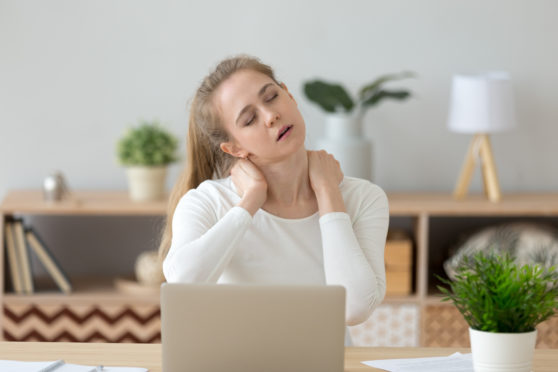
When lockdown made working from home the norm, many Scots’ most pressing concerns were tech set-up, finding a flat surface to stick a laptop on, homeschooling and Zoom calls.
Good posture and back health were probably low in most people’s priorities but that’s something many homeworkers, including myself, have lived to regret. Months of poor posture hunched over laptops have taken their toll. Lockdown has seen a spike in back injuries and demand for chiropractors once consultations resume.
“When you put an unsupported spine together with long hours in poor posture, it is easy to see why there has been an increase in back and neck pain,” said Dr Ross McDonald, president of the Scottish Chiropractic Association.
“It is not only the physical stresses of poor posture that cause back pain. The mental challenges of juggling work and family life in one enclosed space over time can also be a strain.”
I myself am a cautionary tale. With no desk and a hyperactive toddler making it impossible to work at my kitchen table, I resorted to working in bed with my laptop. A big mistake, says Dr McDonald, as “you have no back support. Sitting with your legs horizontal and hunching over to see your laptop screen also changes the curves in the lower part of the spine, potentially straining the lower back.”
About a month ago, I sat down on my bed/office space, felt a horrible twinge in my lower back and stood up into a world of agony. Searing pain darted along my spine and slashed across my lower back. I couldn’t sit, stand or walk without crippling pain.
Over the phone, my GP diagnosed a probable lumbar muscle tear caused by extreme stress placed on my lower back, the painful yet inevitable result of hours spent hunched over a laptop in bed. He prescribed strong painkillers, bed-rest, stretches and gentle walking.
After several weeks of hobbling around, I was finally back at work, having crammed a desk, office chair and laptop stand into my bedroom.
I sought out expert advice on how to avoid back pain while working from home. For a home office, Dr McDonald suggests: “Put your screen in front of you at a comfortable viewing height. Ideally, the monitor should be at arm’s length away, with the top of the monitor at eye level. Sit in front of the screen but do not look down on it.
“Wrists should be straight with hands at or below elbow level. Your arm should be close to the body when using a mouse. Using a small towel or facecloth under the arms can help minimise pressure on the arms against the edges of a table.
“Use a chair with good back support. The height should be adapted so the knees are at or just below the level of the hips. Rest your feet flat on the floor or on a foot support – don’t leave them dangling as this puts pressure on the blood flow into the legs.”
The British Chiropractic Association’s Owain Evans says good posture and moving about regularly by taking short screen breaks is essential.
“If you don’t have a desk chair, put a cushion against the back of your chair and sit with your back fully against it,” he said.
“It’s important not to slouch forward, as this will put extra pressure on your upper back. Sit back into your chair, use your chair’s lumbar support to preserve the curve in your low back, and lean back into your chair to give your postural muscles a break.
“For your neck, roll your shoulders backwards and down away from your ears. These positions help evenly distribute your weight and maintain the natural curvature of your spine.
“Try moving around every 20 to 30 minutes to shake off tension – our spines love movement!”
“And always take a quick walk on your lunch break or do some simple stretches whilst the kettle is boiling for a cuppa.
“If you ever experiencing persistent back pain or mobility issues, you should always seek the advice of your GP or other health professional.”
Exercise your way to better posture
Here are three quick and easy exercises from the BCA’s Straighten Up programme to try at home. They promote balance, strength and flexibility in the spine and help avoid injury while working from home and in everyday life.
Tilting star
Start by standing tall with your ears, shoulders, hips, knees and ankles in a straight line, and belly button pulled in towards your spine. Spread your arms and legs into a star shape.
Facing forward, place one hand in the air with the other at your side. Breathe in as you slowly stretch one arm overhead, while slowly bending your entire spine to the opposite side and sliding the other hand down your thigh. Relax at the end of the stretch, breathing out and in again.
Perform this exercise twice to each side. Easy does it!
Trap openers
Breathe deeply and calmly, relaxing your stomach region. Let your head hang loosely forward and gently turn from one side to the other. Using your fingers, gently massage the area just below the back of your head.
Move down to the base of your neck. Then relax your shoulders and slowly roll them back and forward.
Enjoy for 15 seconds.
Tight rope
From the standing tall position, take a step forward as if on a tight rope. Make sure your knee is over your ankle and not over your toes.
Allow the heel of your back foot to lift. Balance in this position for 20 seconds and then repeat on the opposite side.
For more visit: chiropractic-uk.co.uk/straighten-up-uk

Enjoy the convenience of having The Sunday Post delivered as a digital ePaper straight to your smartphone, tablet or computer.
Subscribe for only £5.49 a month and enjoy all the benefits of the printed paper as a digital replica.
Subscribe